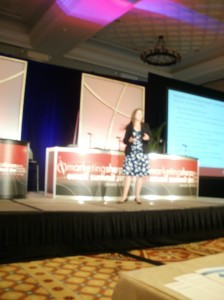 Email marketing strategy independent consultant and MarketingSherpa email marketing trainer, Jeanne Jennings, wrapped up MarketingSherpa Email Summit 2011 at Caesar’s Palace in Las Vegas with a great presentation that offered some quick hit advice illustrated by several case studies.
Email marketing strategy independent consultant and MarketingSherpa email marketing trainer, Jeanne Jennings, wrapped up MarketingSherpa Email Summit 2011 at Caesar’s Palace in Las Vegas with a great presentation that offered some quick hit advice illustrated by several case studies.
Make it so
Jeanne opened the session by outlining the four challenges of email marketing:
- Strategy
- Relevance
- Deliverability
- Return on investment
And she immediately went into the differences between strategy and tactics. In fact, Jeanne admitted when she starts working on an email campaign and starts blocking out the strategy, doing the big picture works gets her so excited she starts getting into tactics too quickly and has to draw back.
Her main definition of strategy is, “A plan of action to achieve a specific goal,” and her description of tactics was to quote Jean Luc Picard of the Starship Enterprise — “Make it so.” Strategy is the plan, or blueprint, of your email marketing campaign, and tactics are the steps or stages you take to turn that strategy into reality.
The case study
The first study she presented was an email campaign for the National Education Association’s Member Benefits Corporation conducted this past holiday season. The NEAMB provides programs and services to the 3.2 million members of the National Education Association. This particular case study is focused on two of the seven steps of efficient email strategy — performing a SWOT analysis and developing a content strategy.
The control for this case study was a catalog list email that often ran several pages, making holiday offers hard to find. The test against the control took a page from the Groupon handbook with a clear offer, and content that based on Jeanne’s description I call “Groupon-lite.”
SWOT analysis
- Strengths — members have highly favorable impression of association, great holiday offers for members, recipients historically responded to discounts, new CMO encourages new idea
- Weaknesses — email had been catalog of offers, limited internal resources and budget for content, limited budget for content freelancers, concern that members are being overrun with mail decreasing response rates, no explicit opt-in; opt-out email permission
- Opportunities — Groupon and other deal emails are popular, people are actively looking to save money in this economy, busy professionals (teachers) are looking for ways to reduce holiday stress, shopping online is becoming more and more popular
- Threats — all the other holiday offer emails, differentiate from those; general inbox clutter makes members look for mail messages, some deals offered by retailers aren’t exclusive to organization
Here are the parameters Jeanne set up for the test email: weekly send; 100% opt-in; content strategy — engaging quotes, gift ideas; single discount offer; low -resource content marketing; quotes and tips from staff; differentiation from National Education Association’s Member Benefits Corporation control and other retail messages.
The quantifiable results
“Holiday cheer” test v. control
- Open rate up 214%
- Clickthrough rate up 105%
- Decrease of 34% in click-to-open because the click rate was so much higher than control
“Holiday cheer” v. internal benchmarks
- Open rate up 185%
- Clickthrough rate up 337%
- Click-to-open up 49%
Jeanne mentioned that conversion data is not available yet for this study.
Roll your sleeves up and get a full day of email training with Jeanne through MarketingSherpa’s Email Marketing Essentials Workshop Training. The next dates include Chicago on Tuesday, April 21, and San Francisco on Thursday, March 10.
Related resources
Ten Numbers Every Email Marketer Should Commit to Memory
Email Marketing: “I am not dead yet”
Welcome Messages: Are You Making a Good First Impression on New Opt-ins?
How a 6 Email Series Increased Unique Key Clickthrough Reach by Nearly 400% Over a Single Email




 Recently, my colleague
Recently, my colleague 





